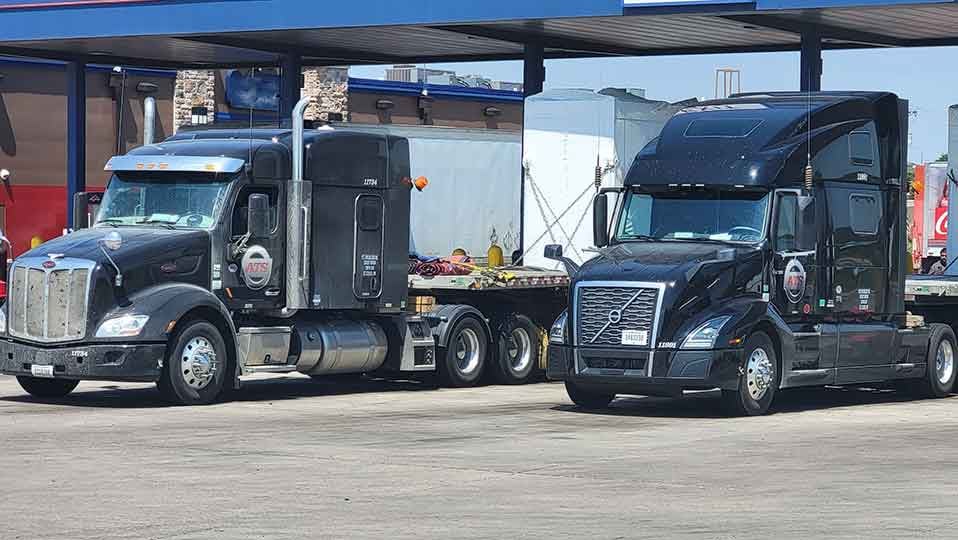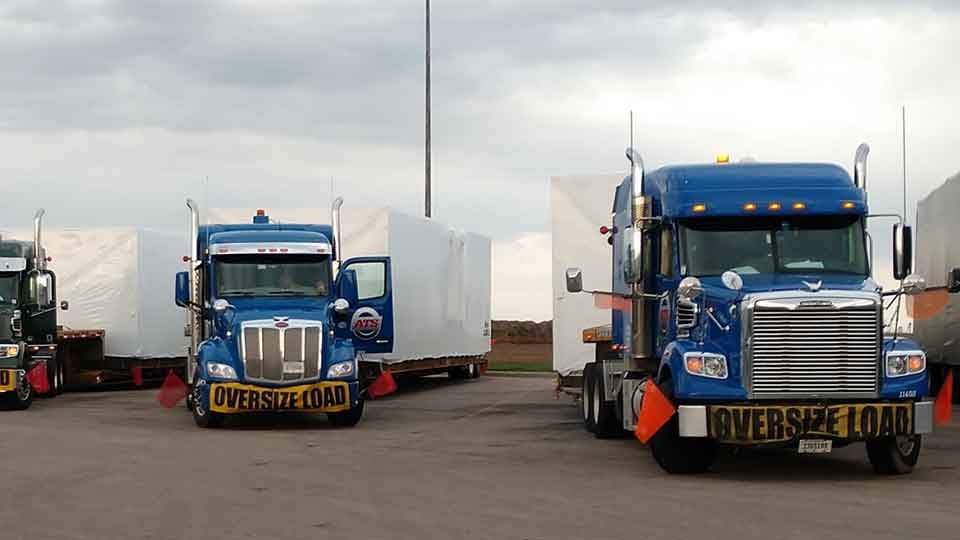As predicted in my forecast article twelve months ago, 2023 was a trying year for trucking companies, truck drivers and transportation industry stakeholders of all kinds.
From record highs in 2021, domestic truckload freight rates continued their downward trajectory, with spot rates bottoming out this year.
Granted, 2023 was a better year for shipper income statements as transportation-related expenses likely demanded a far smaller slice of their “revenue pie” than in prior years. This trend may continue in 2024, stretching transportation companies further than they’re comfortable with.
Then again, the transportation industry is as resilient as it gets, which makes everything harder to predict.
As the chief financial officer at Anderson Trucking Service (ATS), I’ve spent more than two decades in the transportation industry. Over the years, patterns have emerged in the way this marketplace functions, the forces that impact it and how it reacts to each of them.
In this article, I’ll do my best to recap what 2023 brought to transportation and provide a forecast of what 2024 (a leap year, by the way) might mean for shippers and carriers. For your convenience, I've broken down my thoughts into the following sections:
- 2023 transportation industry market recap: feast and famine
- 4 indicators of the transportation industry’s health: recap and projection
- Key takeaway for transporting your freight in 2024
2023 Transportation Industry Market Recap: Feast and Famine
Like a pendulum, leverage within the transportation marketplace swings back and forth between two sides (with shippers on one end and transportation providers on the other).
In such a highly fragmented market, the balance between supply (the number of transportation solutions) and demand (the amount of freight) can swing drastically.
Assisted by what can only be categorized as a freight recession, in 2023 things were firmly in the hands of shippers, who seized the opportunity to lower rates and claw back some of the dollars they spent in 2021. Last year, companies were able to get cargo moved for 20-30 percent less than the previous year.
But what drove this dip in truckload freight rates? And, perhaps more importantly, what can we expect in 2024?
Primarily, three major challenges created a difficult transportation climate in 2023:
- A macroeconomic shift in consumer spending patterns (thus lowering freight demand)
- A resulting oversized pool of capacity
- Continued increasing operating expenses for trucking companies

1) A Macroeconomic Shift in Consumer Spending Patterns
Remember the pandemic shut-downs of 2020-21, when airlines grounded most of their planes, theme parks closed, cruise companies halted bookings and travel stopped? At that time, the way people spent their earnings changed. Bolstered by COVID relief stipends, boredom and nowhere else to spend it, people began spending more money online than ever before.
In June 2020, the percentage of U.S. retail sales that were attributed to e-commerce increased to 16.5 percent, from 11.9 percent in March — an all-time high.
Additional spending on general commodities raised demand within the dry van trucking sector that supports it, pumping money into the hands of drivers across the U.S. and drawing more people into the trucking business.
In 2022, consumer spending patterns changed again as the world re-awakened — travel resumed, concert halls and stadiums sold out and resorts opened their calendars.
With more places to put their money, rising inflation and a hunger to get out of the house, U.S. consumers didn’t purchase as many durable goods in 2023. This has created less work for trucking companies (a primary factor in truckload pricing).
2) A Resulting Oversized Pool of Capacity
Between December 2019 and November 2023, the U.S. trucking market added more than 1.2 million truck drivers, who streamed into the industry in pursuit of elevated rates.
Throughout 2020-21, there was a lot of work for these drivers and plenty of money to be made.
However, economic uncertainty, inflation, a larger portion of consumer dollars going toward services and slower infrastructure growth, shrunk U.S. trucking demands in 2023.
Today, we’re in a freight recession, leaving current drivers with fewer loads to haul and sending rates downward.
 3) Continued Increasing Operating Expenses for Trucking Companies
3) Continued Increasing Operating Expenses for Trucking Companies
Trucking companies have a fixed set of operating expenses — fuel, truck maintenance/parts, new truck purchases, insurance, driver pay, etc. Each of these costs rises and falls periodically, impacting margins when they do.
In 2023, truck maintenance prices rose due to increases in labor costs and parts shortages, new truck prices went up for the third straight year, insurance premiums increased, fuel ended lower (though it was volatile) and truck driver pay fell (increasing driver turnover in its wake).
With the cost of operating a trucking company higher than it had been in a long time and freight rates as low as they were, trucking companies felt the pinch throughout 2023.
Will this continue in 2024 or will the pendulum shift back in the favor of transportation providers? Let’s talk about it. . .
4 Indicators of the Transportation Industry’s Health: Recap and Projection
Today, inflation remains center stage within the U.S. economic picture. While the Fed has had some success in stymieing it, increases in costs still outpaced that of incomes in 2023.
Additionally, as was the case going into last year, more consumers are spending money using credit than they have in recent years. Between Q1 and Q3 2023, U.S. consumers added more than $45 billion of credit card debt with a balance of $1.06 trillion as of August.
This is a concerning trend and indicates that 2024 may be difficult for many segments of the U.S. economy (transportation included). People with more debt have less money to spend on goods and services. Based on the trend we’ve seen over the past couple of years, however, service-based businesses might be more largely disrupted by a drop-off in spending.
Regarding transportation, there are four key indicators of this industry’s overall standing: the demand for transportation services, the supply of transportation services, the cost of providing transportation services and the cost of procuring transportation services.
While we touched briefly on the challenges in these segments in 2023, read on to learn where they currently stand and how I expect them to change in 2024.
Demand for Transportation Services in 2024
Demand for trucking services has been low over the last 18 months. Though the open-deck market has been better than the dry van space, the seasonal demand bumps we’ve come to expect at various points in the year (end of a fiscal quarter, Christmas peak, etc.) haven’t existed as drastically as in years past. I expect this to continue through 2024.
Looking at Consumer Price Index (CPI) data, mortgage rates, household debt-to-income data and U.S. consumption patterns, it’s safe to predict 2024 will be a rough year economically. And, even though some economists have halted their recession predictions, we’re not out of the woods yet. If a recession ensues, expect demand for trucking to falter once more in 2024.
Supply of Transportation Services in 2024
2023 was a difficult year for trucking companies. 2024 will be very similar. While Department of Transportation (DOT) registration numbers don’t reflect a mass industry exodus (registrations are renewed each year), there has been very high turnover within trucking fleets over the past 12 months.
Historically, high turnover (as truck drivers search for higher pay) is the first sign of capacity leaving the market at scale.
Q1 every year is a very quiet time in the transportation industry. I expect a good amount of capacity to leave the trucking industry between Q1 and Q2 of 2024, spurred (in no small part) by the continued pressure of low demand, depressed rates and high operating expenses.
This correction (capacity leaving the industry), should help bring supply and demand closer to a balance.
 The Cost of Providing Transportation Services in 2024
The Cost of Providing Transportation Services in 2024
As I laid out above, the major expenses trucking businesses contend with are fuel, insurance, truck purchases/payments, equipment maintenance and truck driver salaries. Here’s where I see each of these costs going in 2024:
Fuel:
Fuel prices are volatile, making this expense kind of a wild card. That said, they’ve been edging downward for more than five months now. I don’t think we’ll see any significant increases in fuel prices in 2024, barring a significant global event or production cut.
Insurance:
You can’t run a trucking company without insurance. This has been rising for years and I expect insurance to take another hike in 2024. This will impact individual drivers, for-hire fleets and private fleets.
Truck Purchases/Payments:
Due to production issues, labor shortages and supply chain congestion, the price of a new semi-truck has been rising since 2020. Although manufacturers have been doing a better job of meeting replacement levels (308,000 trucks produced in 2023), the price of new trucks will be up again in 2024.
Equipment Maintenance/Parts:
A large downside of high new-truck prices and production shortages is that fleets have had to run trucks for longer than they otherwise would. This has increased equipment wear and tear and accelerated the frequency of equipment maintenance. Worldwide labor and parts costs have also increased the cost of maintenance over the last few years. This will continue in 2024 and I expect fleets to experience production issues as maintaining equipment requires more downtime.
Truck Driver Pay:
As the backbone of our industry, truck drivers are the most essential piece of every trucking company and most supply chains. In 2023, truck driver pay was far lower than it had been in years, as rates declined. In 2024, driver pay will remain moderate. This could lead to some drivers exiting the industry entirely, opting instead for jobs in other industries.
The Cost of Procuring Transportation Services
Freight rates are the final piece of this puzzle. The balance between market supply, freight demand and operating expenses dictates truckload freight rates. In 2024, I expect demand to remain low, particularly in the dry van sector, most expenses to rise and for capacity to exit the market before mid-year.
In the end, we probably won’t see a significant change in freight rates until the latter half of the year.
January-April is the time of year when the largest portion of RFQs are conducted within the truckload transportation sector. At this time, we should see a large number of shippers tightening their spend again, trying to eke out as much savings as possible in 2024.
However, with the extreme cost pressures carriers are currently facing, many of the companies that win these bids might not be able to move the actual freight at those rates. If this happens, I predict we’ll see a large volume of freight brought to the spot market in 2024 as companies look for reliable transportation coverage.
Key Takeaway For Transporting Your Freight in 2024
No matter where you are in the transportation world, I expect the first quarter of 2024 to be a very active bid season.
As you conduct your transportation bids, focus on working with companies that have the assets to provide the services you need. That means don’t work with new or unstable companies and make proper vetting of your transportation providers a priority. This will ensure you’re not left in the lurch as money gets tighter for your carriers in 2024.
Need Help With Planning in 2024? This Will Help
2024 will be challenging for transportation companies and shippers alike. Freight rates will remain lower than they have been in years (especially in the dry van realm) and expenses will stay high. As recession talks linger and consumers borrow more money than ever, it’s difficult to predict how much will change over the year ahead. Demand probably won’t pick up in 2024 and supply (the number of for-hire carriers/trucks) should decline in the months ahead.
For shippers, this is a great time to save money on freight rates. While working with stable, reputable carriers that have the infrastructure and assets to provide the services you’re looking for, also make sure that your shipping schedule is fully optimized.
Download this 2024 Freight Shipping Calendar, which outlines which days are the most (and least) expensive to ship freight on this year.
Finally, if you have any questions about ATS and how our stability can benefit companies like yours in 2024, contact us. We’re happy to help you in any way you need.


